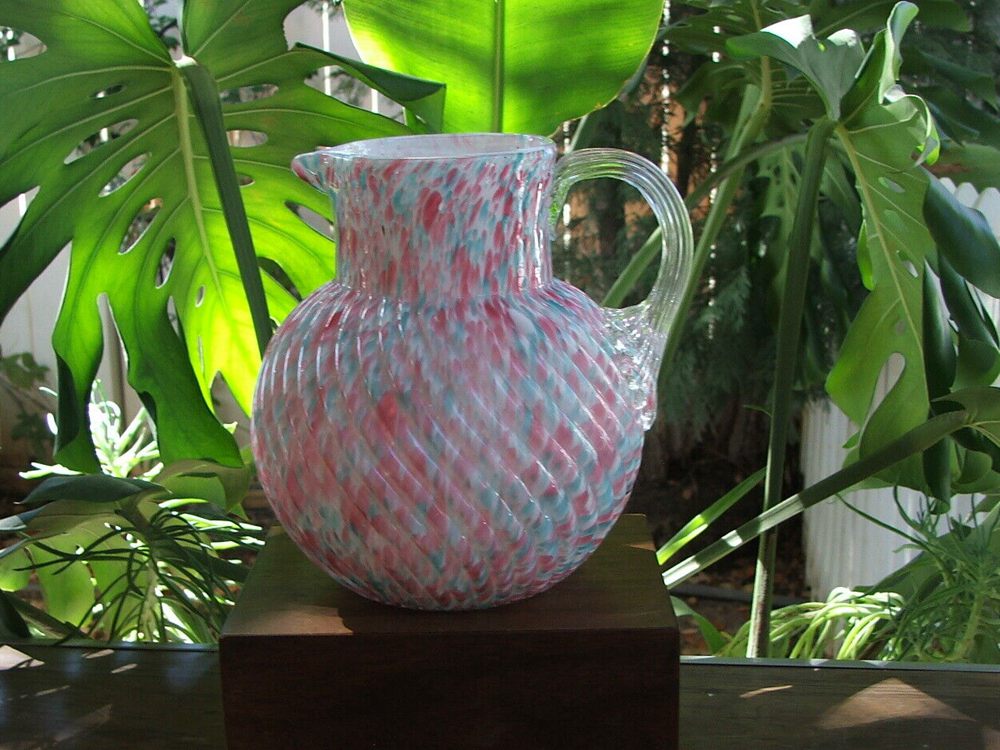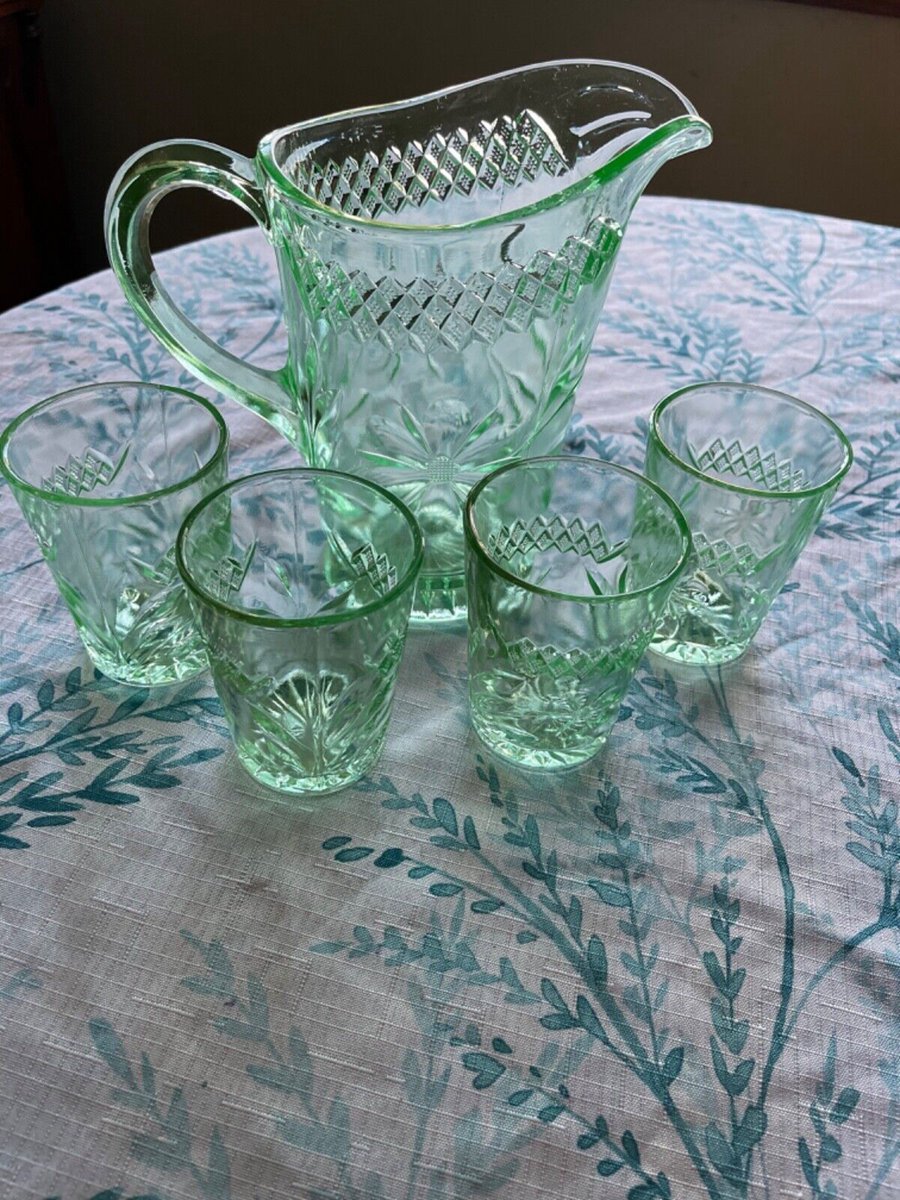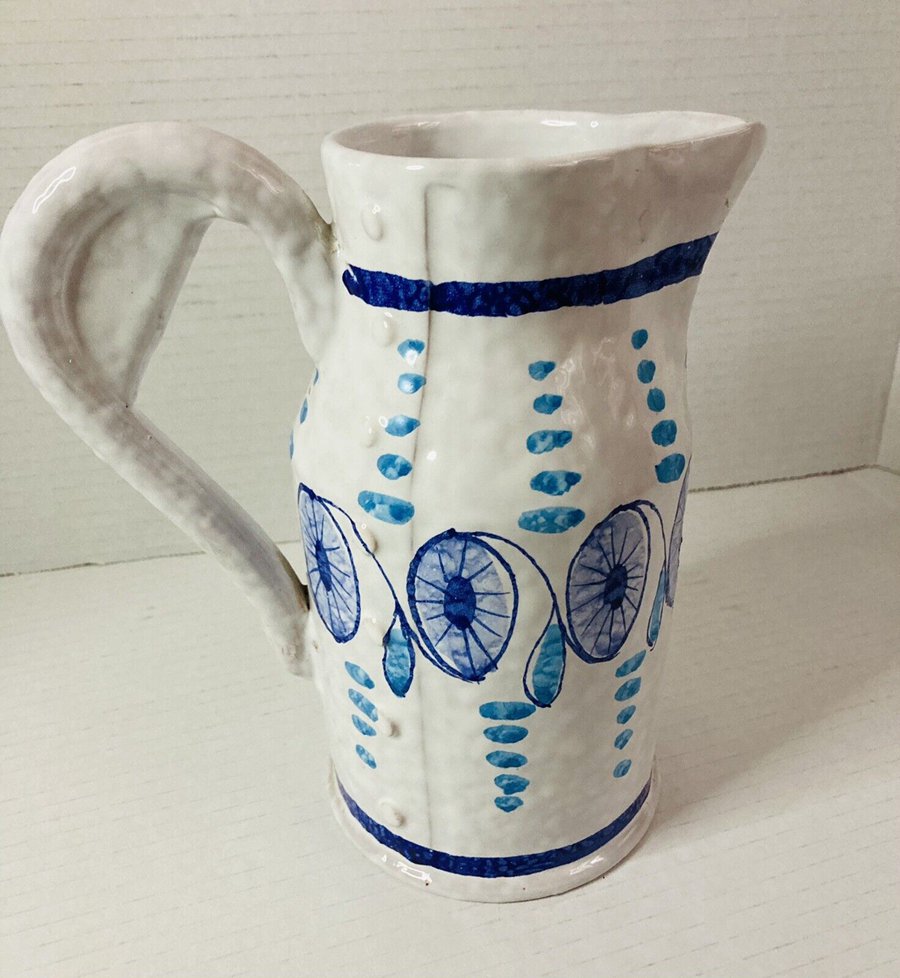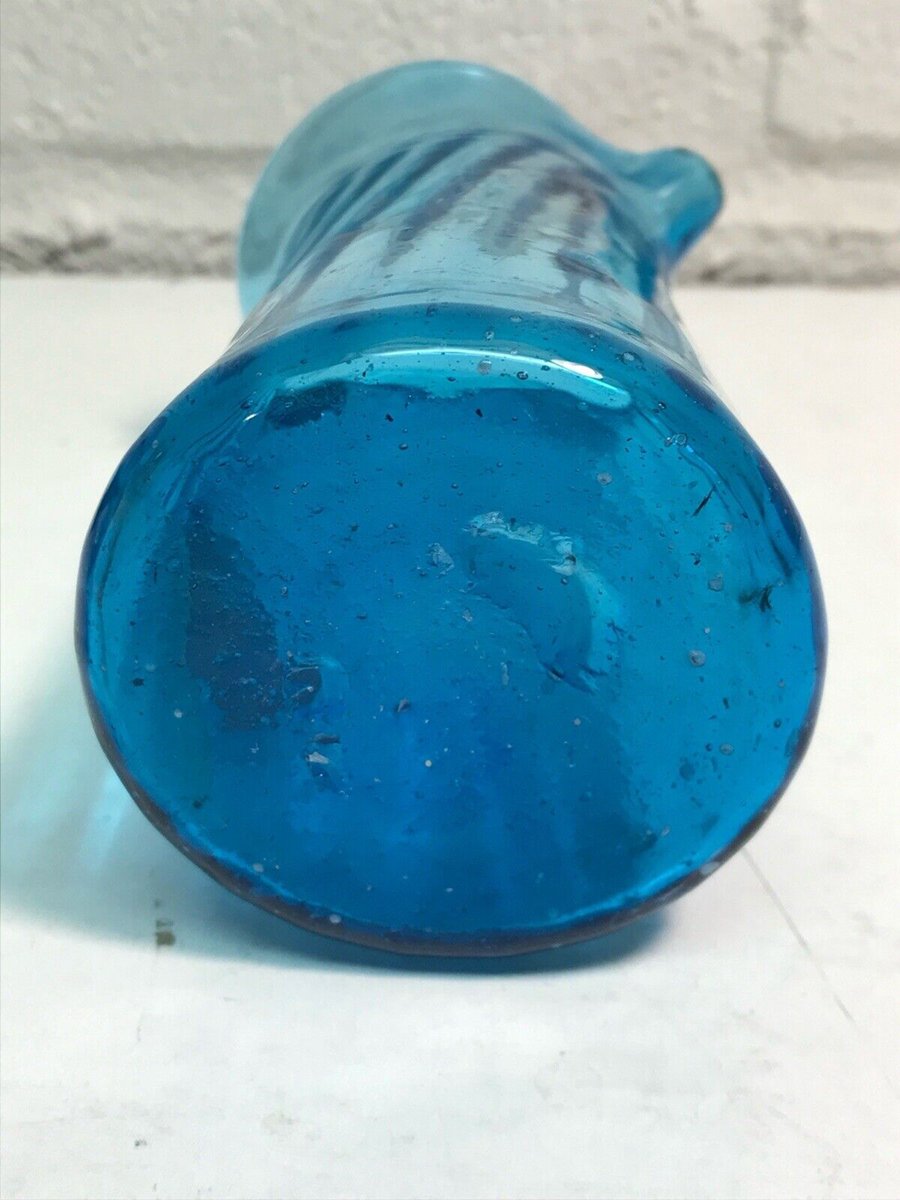Antique glass pitchers are a prized possession for many collectors and enthusiasts, offering a glimpse into the past while showcasing the craftsmanship and artistry of glassmakers throughout history. In this article, you’ll learn about the fascinating history of these beautiful and functional pieces, along with pointers on identification and determining their value.
As you delve into the world of antique glass pitchers, you’ll come across various styles, such as cut glass, pressed glass, and etched glass, each with its own unique characteristics and charm. Understanding the nuances of these styles, as well as factors like age, condition, and provenance, will aid you in identifying these treasures and assessing their worth. In some cases, rare or historically significant pieces can fetch thousands of dollars, making accurate identification and valuation crucial for collectors and buyers alike.
In addition to styles, you’ll learn how to spot key identifiers, such as glass weight, markings, and the presence of bubbles, which can offer insights into a glass pitcher’s origins and craftsmanship. Equipping yourself with this knowledge will not only enhance your appreciation for these stunning works of art but will also help you build a collection that is both valuable and personally meaningful. So, let’s begin your journey into the world of antique glass pitchers.
Table of Contents
History of Antique Glass Pitchers
Evolution of Pitcher Designs
The history of antique glass pitchers can be traced back to the medieval period. In the early stages, the design of these pitchers resembled pots with narrow necks, blown sides, and seams. As time progressed, significant changes in the designs of antique glass pitchers came into play during the 19th century.
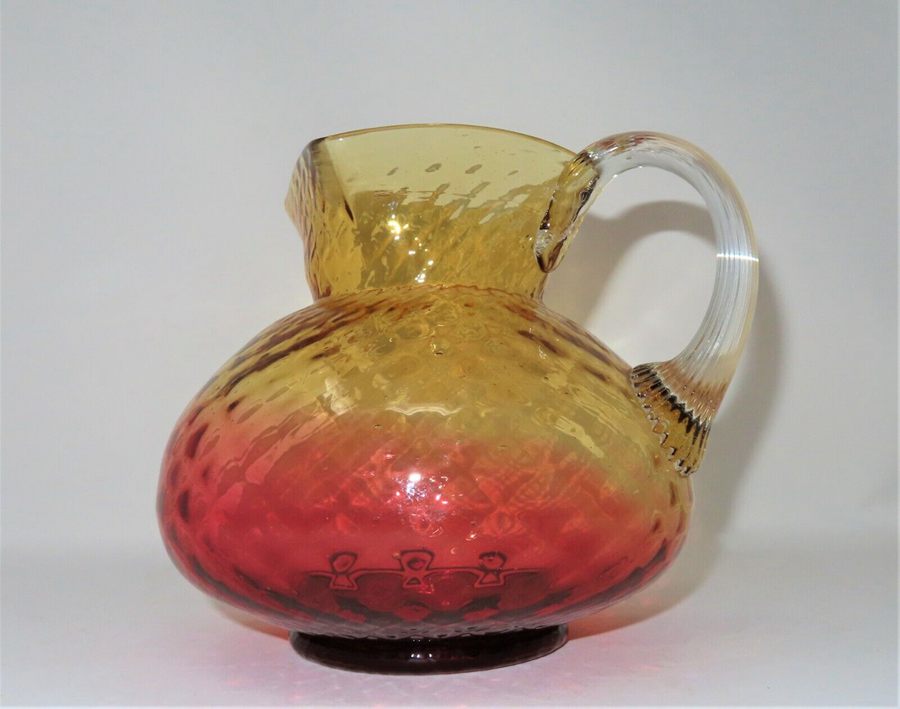
Pressed glass pitchers became popular, made by pressing molten glass into a mold to create a raised design on the surface of the pitcher. These designs ranged from simple geometric shapes to intricate patterns of flowers or animals. Another popular style during the 18th and 19th centuries was the cut glass pitcher, made by cutting pieces from a larger glass sheet, resulting in an interlocking pattern on the surface.
Significant Glass Companies
Throughout the history of glassmaking, several significant glass companies have contributed to the evolution of antique glass pitchers.
- Tiffany: Known for their exquisite art glass and stained glass creations, Tiffany’s unique designs lent themselves well to antique glass pitchers. Their iridescent and colorful finishes made them stand out from other glassware of the time.
- Steuben: As one of the foremost American glass manufacturers, Steuben Glass Company focused on creating high-quality, elegant glassware. Their hand-blown and innovative designs were celebrated for their beauty and luxury.
- Fenton Glass Company: Founded in the early 20th century, Fenton Glass Company focused on handmade art glass pieces, offering a range of beautifully designed antique glass pitchers and other glassware.
- Durand: Known for their golden iridescent finish, Durand glass pitchers were crafted with the utmost attention to detail and were highly sought after by collectors.
- Quezal: Similar to Durand, Quezal glassware showcased iridescent finishes and intricate patterns to create stunning antique glass pitchers that remain highly valued to this day.
As you explore the history of antique glass pitchers, you will come to appreciate the craftsmanship and artistry that went into creating these beautiful pieces of kitchen tableware. The rich legacy of glassmaking and the role of significant glass companies will give you a greater understanding of the value and worth of these timeless pieces.
Styles and Techniques
Cut Glass Pitchers
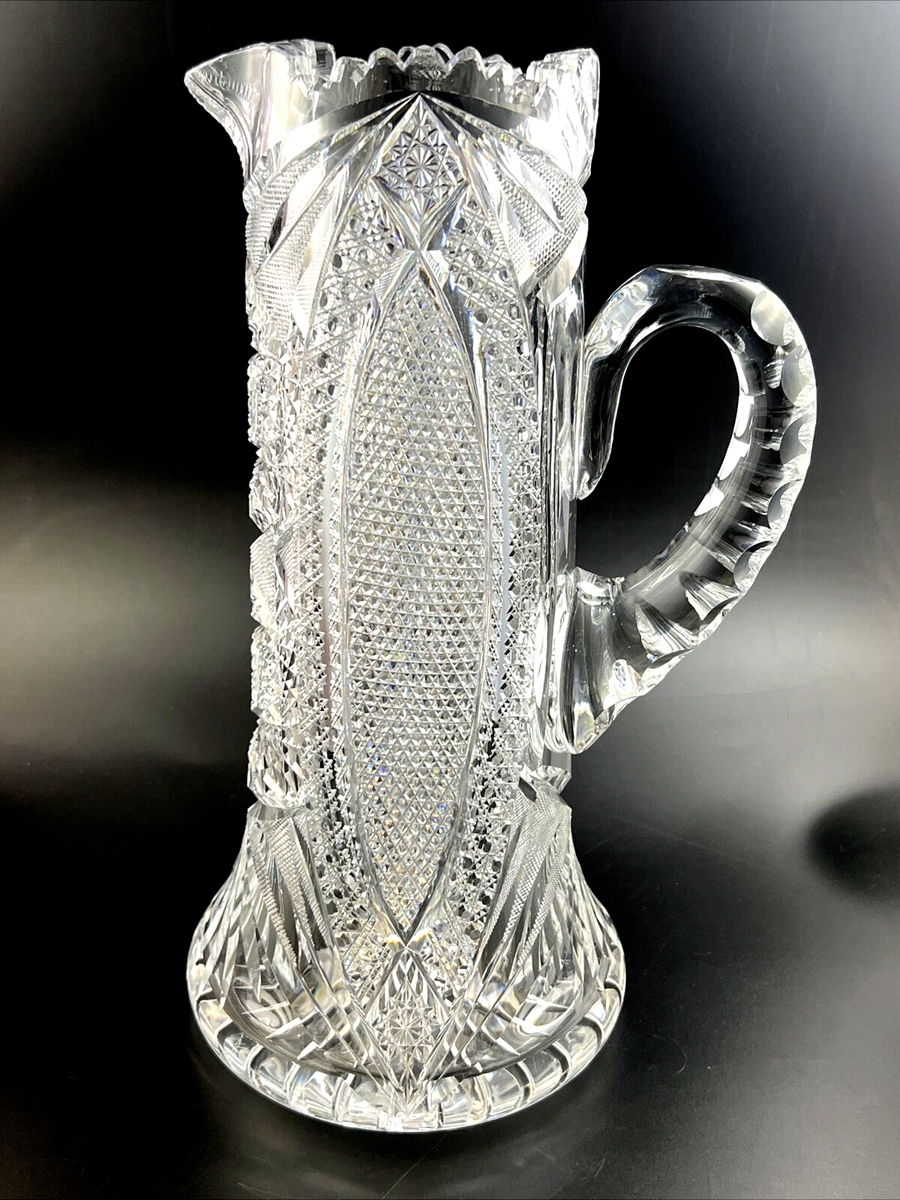
Cut glass pitchers are made by cutting pieces from a larger glass sheet, resulting in an interlocking pattern of shapes on the surface. This style gained popularity in the 18th and 19th centuries. To identify cut glass pitchers, look for intricate patterns and deep grooves in the glass. The value of cut glass pitchers can range widely, depending on factors like age, rarity, and condition.
Pressed Glass Pitchers

In the pressed glass technique, molten glass is poured into a mold and then pressed to create the desired shape and pattern. Pressed glass pitchers typically have simpler designs than cut glass pitchers. The value of pressed glass pitchers also varies, with factors like age, rarity, and condition affecting their worth.
Molded Glass Pitchers
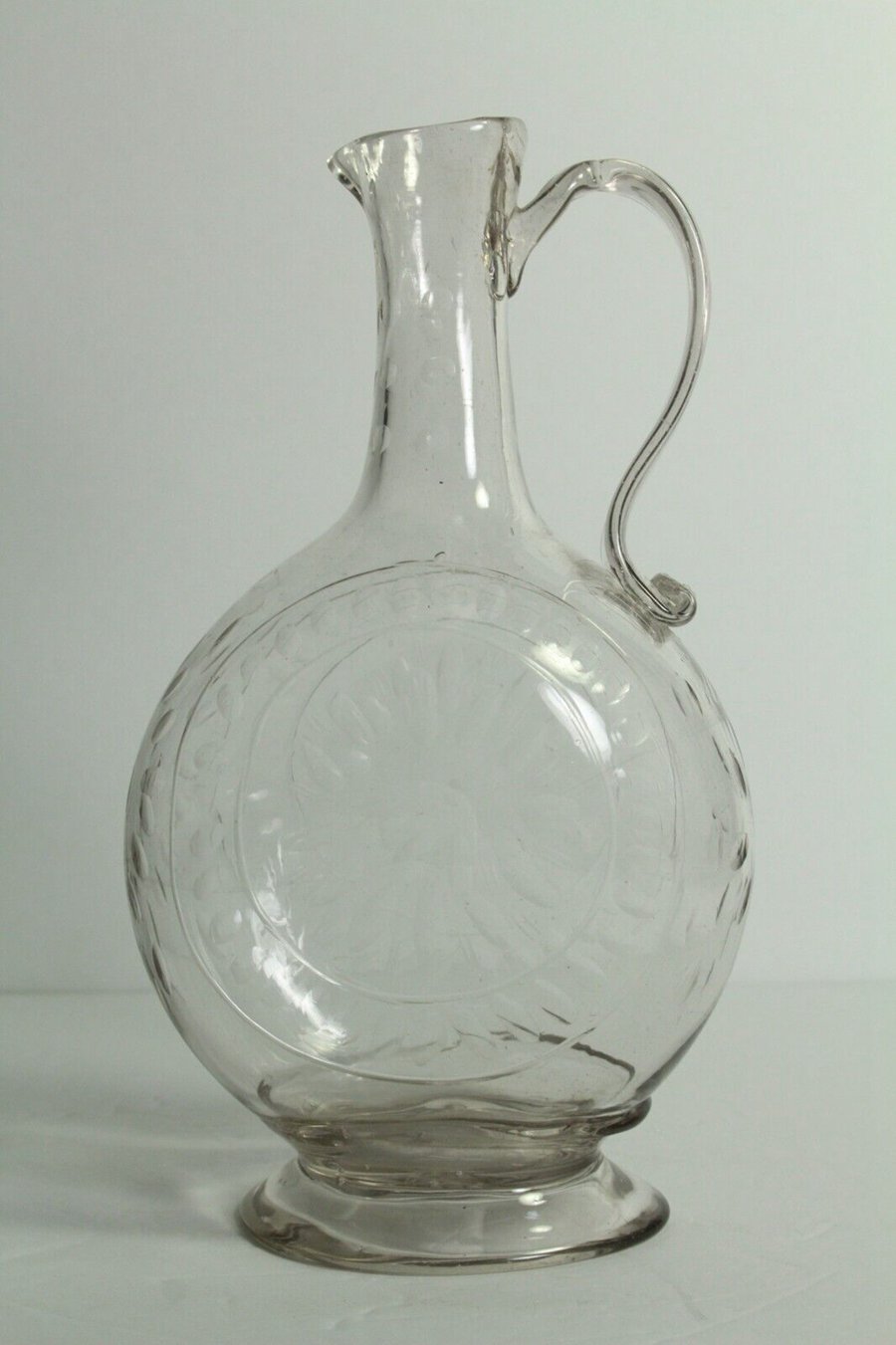
Molded glass pitchers are produced by blowing molten glass into a mold to create a variety of shapes and designs. These pitchers can be handmade or machine-made, and they often feature intricate patterns and unique shapes. Molded glass pitcher values can range from affordable to highly valuable, depending on factors such as age, rarity, and manufacturer.
Etched Glass Pitchers
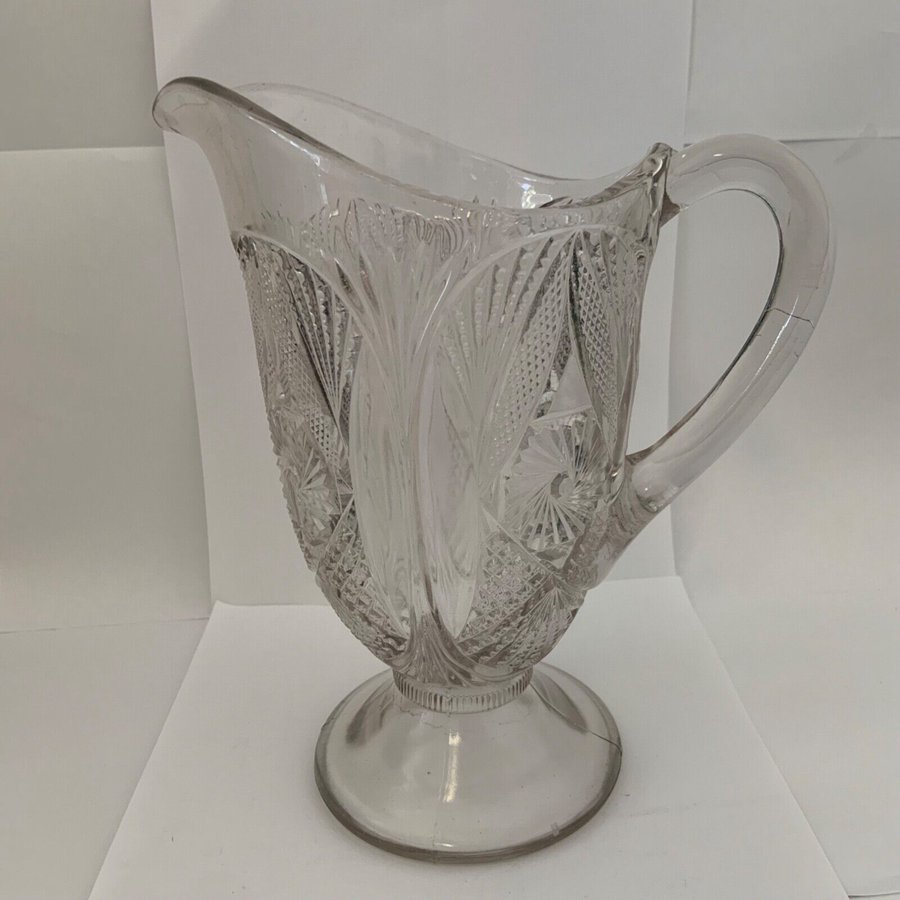
Etched glass pitchers feature designs that are created through a chemical process that removes a thin layer of glass to create detailed patterns and images. These pitchers can be highly collectible, and their values depend on factors like age, rarity, craftsmanship, and the artist responsible for the etching.
Carnival Glass Pitchers
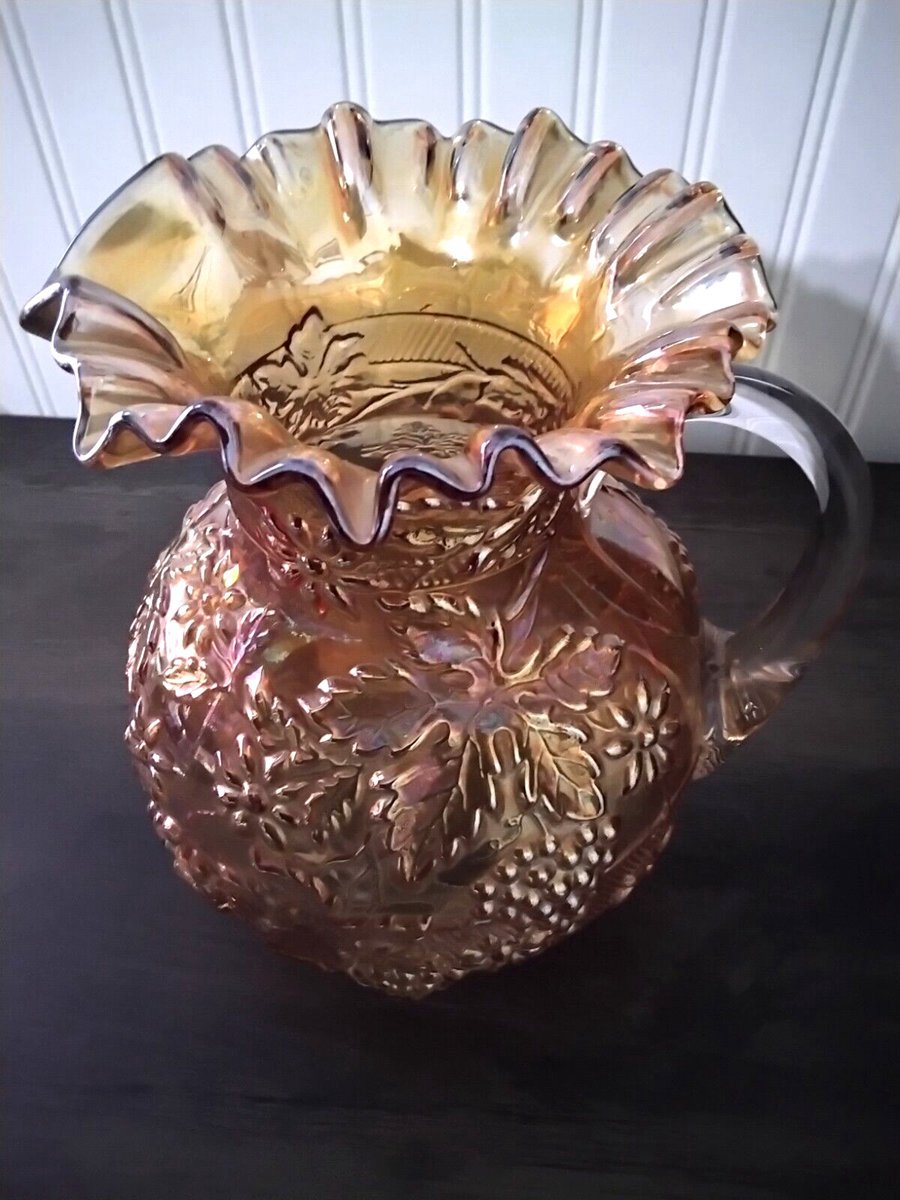
Carnival glass pitchers are characterized by their iridescent surface, which is created by spraying a metallic solution on the glass while it is still hot. They are often found in vibrant colors and intricate patterns, making them highly collectible. Carnival glass pitcher values can range from modest to high, depending on factors such as age, rarity, and condition.
Depression Glass Pitchers
Depression glass pitchers were produced during the Great Depression, often as giveaways by companies to boost sales or as promotions. They are made from inexpensive, machine-pressed glass and typically feature simple designs. Depression glass pitcher values can vary, with some colors and patterns being more valuable than others.
Milk Glass Pitchers

Milk glass pitchers are made from opaque white glass that often resembles the texture of milk. These pitchers can have simple or intricate designs, and they were popular during the 1900s. Milk glass pitcher values can range from low to moderate, depending on factors like age, rarity, and condition.
Identification and Dating Techniques
Colors and Patterns
When identifying antique glass pitchers, pay attention to the colors and patterns. Antique glass pitchers come in a variety of colors, such as green, amber, cobalt, and yellow. However, transparent and white glass pitchers are usually considered more valuable. Look for unique and intricate patterns on the surfaces, indicating hand-crafted designs.
Seams and Markings
Examine the seams and markings on the antique glass pitcher. Handmade glass pitchers often have irregular seams, while mass-produced items might have more consistent seams. Furthermore, authentic antique glass pitchers may display imperfections such as bubbles or pontil marks, which can help determine the age and authenticity of the piece.
Pontil Marks
Pontil marks are a crucial aspect to consider when identifying antique glass pitchers. A pontil mark is a scar left on the base of the glass after it has been detached from the glassblower’s rod, indicating that the item was handmade. Presence of a pontil mark can signify that the pitcher is genuinely antique.
Patent Numbers
Look for patent numbers on the glass pitchers, as they can provide valuable information about the pitcher’s age and maker. You can typically find patent numbers on the bottom of the pitcher or etched into the glass. Once you have the patent number, search for it online to find the corresponding date and manufacturer.
Thermoluminescence Dating
Thermoluminescence dating is a scientific method that measures the amount of accumulated radiation in pottery or glass objects. While it is primarily used for dating archaeological materials, it can also help determine the age of antique glass pitchers. However, this method might require professional assistance and can be expensive.
By paying close attention to the colors, patterns, seams, markings, pontil marks, patent numbers, and considering thermoluminescence dating techniques, you can accurately identify and date antique glass pitchers. This information can aid in determining the value and historical significance of the pieces in your collection.
Determining Value and Rarity
Condition and Quality
One of the primary factors you should consider when determining the value of an antique glass pitcher is its condition and quality. A pitcher in exceptional condition, with no chips, cracks, or other damages, will be more valuable than one with visible flaws. The weight and base of the pitcher may also indicate the quality, with heavier and sturdier bases often signifying a well-made piece. You should also pay attention to the clarity and color of the glass, as these can impact the rarity and appeal to collectors.
Age and Provenance
The age of your antique glass pitcher plays a crucial role in its value. Generally, older pieces are more valuable and sought after by collectors. Look for clues in the pitcher’s design and markings that can help you date the piece. If you can trace the provenance, or ownership history, of the pitcher, this may also add to the overall value. For instance, if the pitcher has been owned by a famous person or has an intriguing backstory, it may be considered more valuable and one-of-a-kind.
Demand and Popularity
Finally, consider the demand and popularity of the glass pitcher you’re trying to value. Some vintage glass patterns and styles may be rare but are not highly sought after by collectors, resulting in a lower value. Conversely, more common designs can still fetch higher prices if they are especially popular amongst collectors.
To assess demand and popularity, you can research online platforms frequented by collectors or consult with experts in the field. By understanding the current trends and preferences of collectors, you can better gauge the potential value of your antique glass pitcher.
Remember, the value of an antique glass pitcher can range between $20 to $600 or more, depending on various factors such as condition, age, and demand. To ensure the accuracy of your valuation, consider consulting with an expert or seeking additional resources to supplement your own knowledge and findings.
Notable Glass Pitcher Types
Water Pitchers
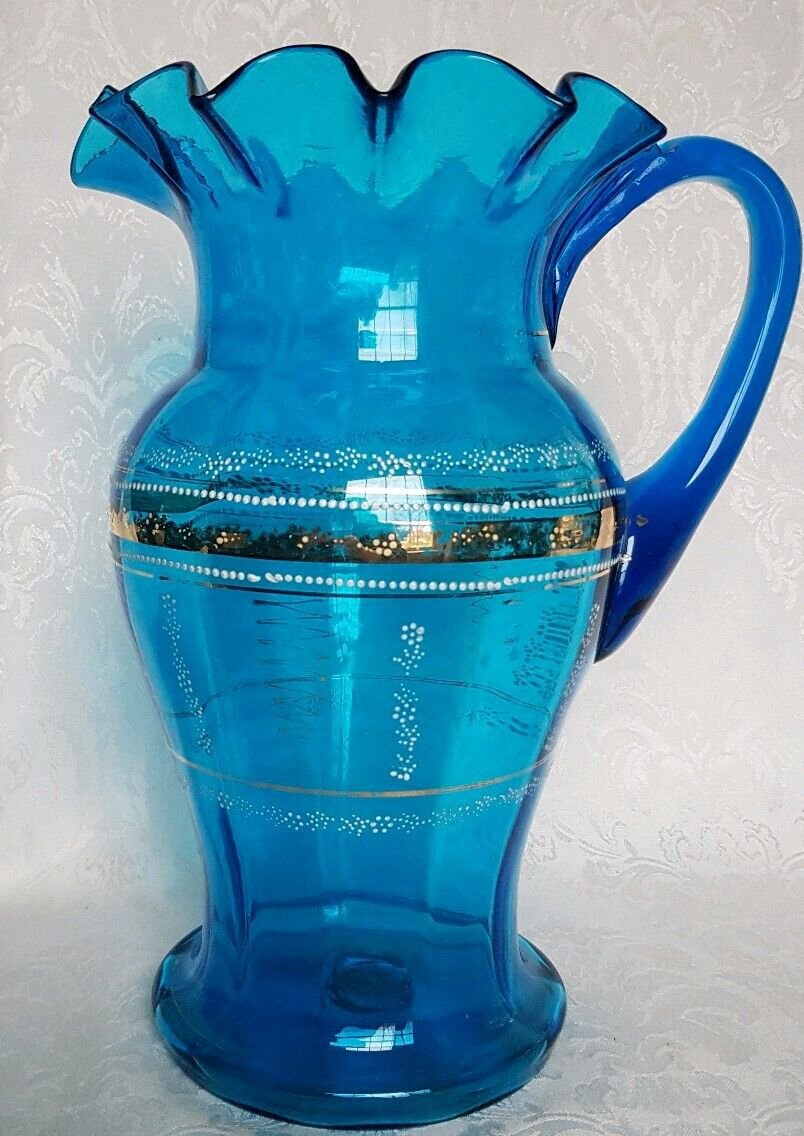
Water pitchers are antique glass pitchers originally intended for serving water. These pitchers often feature intricate designs on the surfaces and handles. Identifying authentic antique glass water pitchers involves examining them closely for characteristics like bubbles, pontil marks, or hand-carved designs. Typically, water pitchers made from transparent or white glass are more valuable, though colored options such as green, amber, cobalt, and yellow are also sought after. The valuation range for antique water pitchers can vary greatly, from $100 to a few thousand dollars, depending on factors such as age, rarity, and condition.
Cream Pitchers

Cream pitchers are smaller than water pitchers and were used for serving cream or milk. Two common types of antique cream pitchers include pressed glass pitchers and cut glass pitchers. Pressed glass pitchers were popular in the 19th century. They were made by pouring molten glass into a mold, forming a raised pattern on the surface. Cut glass pitchers, on the other hand, were crafted by cutting away pieces of glass from a larger sheet, leaving interlocking shapes as the design. These pitchers were especially popular in the 18th and 19th centuries. Similar to water pitchers, the value of cream pitchers depends on factors such as age, rarity, and condition, usually ranging from $100 to several thousand dollars.
Elegant Glassware
Elegant glassware refers to fine-quality glass pitchers made from crystal glass. These pitchers often feature detailed patterns, beautiful colors, and a high-quality finish. Some well-known examples of elegant glassware include names like Heisey, Cambridge, and Fostoria. Antique elegant glass pitchers often have a higher value than their mass-produced counterparts due to their exquisite craftsmanship, ranging from a few hundred to several thousand dollars.
When collecting antique glass pitchers, it’s essential to pay attention to details, such as the pitcher’s design, color, and overall condition, as they play a significant role in determining the value. Be sure to carefully inspect each piece and enjoy the beauty and history of these timeless treasures.
Popular Patterns and Designs
When exploring the world of antique glass pitchers, it’s essential to recognize some of the popular patterns and designs that you may come across. These patterns can give you insight into the history and value of the piece.
Colored Glassware
Antique glass pitchers can be found in an array of colors, with each hue offering its own unique appeal. The most common colors to look for include:
- Green: Green glassware was popular in the early 20th century and often symbolizes elegance and timelessness.
- White: White glass, also known as milk glass, is a versatile color that showcases intricate designs and patterns exceptionally well.
- Amethyst: A deep purple hue, amethyst glassware has an enchanting, regal quality that can be a valuable addition to your collection.
Textures and Patterns
The texture of the glass and the specific design pattern on your antique glass pitcher can significantly impact its value. Here are some sought-after patterns you should look for:
- Frosted Glass: Frosted glass creates a stunning effect by giving the surface a soft, satiny appearance. This technique can accentuate the patterns and designs on your pitcher.
- Dots, Rays, and Ribs: These geometric patterns were highly popular in antique glassware, imparting a sense of sophistication and craftsmanship to the piece.
- Floral Pattern: Floral patterns showcase the artistic finesse of the glassmaker, featuring intricate flowers and vines. These designs can make your pitcher stand out as a coveted item.
Complementary Pieces
When collecting antique glass pitchers, you may also come across accompanying items that can add value and significance to your collection. One such example is:
- Creamers: Antique glass creamers are a popular addition to any glassware collection, often featuring similar patterns and designs to their larger pitcher counterparts.
Remember, as you explore the world of antique glass pitcher designs and patterns, your knowledge and attention to detail will be instrumental in identifying valuable and unique pieces. With this understanding, you’ll be well-equipped to grow and appreciate your antique glassware collection.
Caring for Your Antique Glass Pitcher Collection
Caring for your antique glass pitcher collection is essential to maintain its value and beauty. Here are some tips to help you preserve and care for your collection:
Handling
Antique glass pitchers can be thin and delicate, so always handle them with care. Make sure your hands are clean and free of any lotion, as this can leave residue on the glass. When lifting a pitcher, support both the handle and the base to distribute the weight evenly.
Cleaning
Clean your antique glass pitcher gently and avoid rubbing the surface too hard as it may cause scratches. Use mild soap and warm water to clean them. To remove water spots and residue, rinse the glassware in distilled water. Be cautious when cleaning crystal glassware, depression glassware, or elegant glassware as these are more delicate than other types of glass.
Storing
To protect your antique glass pitcher collection, store them in a safe, dust-free environment away from direct sunlight. Keep plates, tumblers, and other glassware separated by using felt dividers or acid-free tissue paper to prevent scratches and breakage. Display your collection in a secure cabinet or on sturdy shelves.
Recognizing Unique Features
Be mindful of the presence of bubbles or imperfections in the molten glass, as these can add to the authenticity and value of your pitchers. Some pieces, like Jeannette Bottle Works’ custard glass or depression-era glassware, may have manufacturer-specific markings or features that should be preserved.
By following these guidelines, you can ensure your antique glass pitcher collection remains in excellent condition for years to come.
Final Thoughts
As you explore the world of antique glass pitchers, remember to focus on their history, identification, and value. The earliest glass pitchers resembled pots with narrow necks and blown sides, gaining more intricate designs in the 1830s with the addition of lids.
When identifying antique glass pitchers, you should pay attention to various factors, such as age, condition, and design. Look for unique features like cut glass patterns, which were popular during the 18th and 19th centuries, and pressed glass pitchers. Additionally, consider the production date, type, and color when evaluating a piece’s value.
It’s essential to keep in mind that the value of antique glass pitchers can range from $20 to several thousand dollars. Your collection may include objects worth around $100 to $3000, with rare, high-value pieces being associated with famous people or limited production. As with any collectible, it’s crucial to educate yourself and develop a keen eye for details to ensure that you’re making knowledgeable decisions when purchasing or appraising antique glass pitchers.
In summary, embrace the fascinating aspects of antique glass pitcher history, refine your identification skills, and stay informed about market values. By doing so, you will enjoy the process of collecting and recognizing the worth of these elegant and timeless pieces.
FAQ
How can I identify the age of an antique glass pitcher?
To determine the age of a glass pitcher, you should examine its design, craftsmanship, and any distinguishing marks or signatures. Look for clues such as:
- The glass-making technique (e.g., cut glass, blown glass, pressed glass)
- The presence of a manufacturer’s mark, which may be etched, engraved, or embossed
- Style, design, and colors consistent with specific periods or regions
What factors affect the value of an antique glass pitcher?
The value of an antique glass pitcher depends on several factors:
- Age: Older, rarer pieces are usually more valuable
- Condition: Flaws, chips, or cracks will decrease the value, while pristine condition will increase it
- Design: Unique, intricate, or highly sought-after designs command higher prices
- Provenance: Pieces with a documented history or association with a famous person or event can fetch a premium
- Scarcity: Limited production or few surviving examples can increase demand and value
How much can I expect to pay for an antique glass pitcher?
The price for antique glass pitchers varies widely, from around $20 for common pieces to $600 or more for highly sought-after examples. Some rare and exceptional items can sell for thousands of dollars. Keep in mind that these prices can fluctuate based on the factors discussed above.
What are some popular types of antique glass pitchers?
There are numerous types of antique glass pitchers, including:
- Cut glass pitchers, which feature intricate patterns created by cutting the glass surface
- Blown glass pitchers, made by inflating molten glass and often showcasing unique shapes and colors
- Pressed glass pitchers, produced by pressing glass into a mold for a uniform appearance
Additionally, specific glass manufacturers or historical periods may have their own signature styles or patterns. Examples include Depression-era glass pitchers, Federal Glass Company pieces, or those made by famous glass artisans.
Remember, identifying antique glass pitchers requires effort and research, but with patience and attention to detail, you can uncover the history and value of these beautiful pieces.

